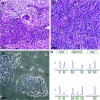Verification and unmasking of widely used human esophageal adenocarcinoma cell lines
- PMID: 20075370
- PMCID: PMC2902814
- DOI: 10.1093/jnci/djp499
Verification and unmasking of widely used human esophageal adenocarcinoma cell lines
Abstract
For decades, hundreds of different human tumor type-specific cell lines have been used in experimental cancer research as models for their respective tumors. The veracity of experimental results for a specific tumor type relies on the correct derivation of the cell line. In a worldwide effort, we verified the authenticity of all available esophageal adenocarcinoma (EAC) cell lines. We proved that the frequently used cell lines SEG-1 and BIC-1 and the SK-GT-5 cell line are in fact cell lines from other tumor types. Experimental results based on these contaminated cell lines have led to ongoing clinical trials recruiting EAC patients, to more than 100 scientific publications, and to at least three National Institutes of Health cancer research grants and 11 US patents, which emphasizes the importance of our findings. Widespread use of contaminated cell lines threatens the development of treatment strategies for EAC.
Figures

Comment in
-
Identification of bona fide esophageal adenocarcinoma cell lines.J Natl Cancer Inst. 2010 Feb 24;102(4):212-3. doi: 10.1093/jnci/djp526. Epub 2010 Jan 14. J Natl Cancer Inst. 2010. PMID: 20075369 No abstract available.
References
-
- Masters JR. Human cancer cell lines: fact and fantasy. Nat Rev Mol Cell Biol. 2000;1(3):233–236. - PubMed
-
- Jemal A, Siegel R, Ward E, et al. Cancer statistics, 2008. CA Cancer J Clin. 2008;58(2):71–96. - PubMed
-
- Paulson TG, Reid BJ. Focus on Barrett's esophagus and esophageal adenocarcinoma. Cancer Cell. 2004;6(1):11–16. - PubMed
-
- Trauth BC, Klas C, Peters AM, et al. Monoclonal antibody-mediated tumor regression by induction of apoptosis. Science. 1989;245(4915):301–305. - PubMed
Publication types
MeSH terms
Substances
Grants and funding
LinkOut - more resources
Full Text Sources
Other Literature Sources
Medical
Research Materials
Miscellaneous

